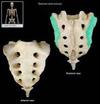Test 1 Flashcards
(357 cards)

vomer

humerus lesser tubercle

inferior angle

internal auditory meatus

squamous portion

styloid process

sacrum auricular surface

supraorbital foramen

pubofemoral ligament

radius head
collagen
1/3 of bone, adds flexibility
Abdominal cavity
Liver, stomach, spleen, kidneys, pancreas, intestines

fovea capitus
fibrocartilage
supporting connective tissue, symphysis pubis, intervertebral discs (the matrix is rich in collagen, resists compression)

ribs body
Caudal
Towards pelvis
List the eleven organ systems
Integumentary, skeletal, muscular, nervous, endocrine, cardiovascular, lymphoid, respiratory, digestive, urinary, reproductive

mandible ramus

humerus coronoid fossa
what is the second step of the endochondraal ossification process?
Hyaline cartilage model>blood vessels of perichondrium bring in osteoblasts to form periosteum collar>hypertrophy and death of cartilage cells at primary ossification center (diaphysis)>invasion of blood vessels and osteoblasts at primary ossification center> bone begins to replace cartilage (osteoblasts form spicules)>formation of secondary ossification center in epiphysis>bone replaces cartilage at secondary ossification center>hyaline cartilage remain in the epiphyseal plate (until growth is done) and on articular cartilage (for life)
describe the six basic shapes of bones
long bones
short bones
irregular bones
sesamoid bones
flat bones
sutural bones
protein fibers/ connective tissue fibers
collagen, elastic, reticular fibers

coracoacromial ligament

dense regular connective tissue
















































































































































































































